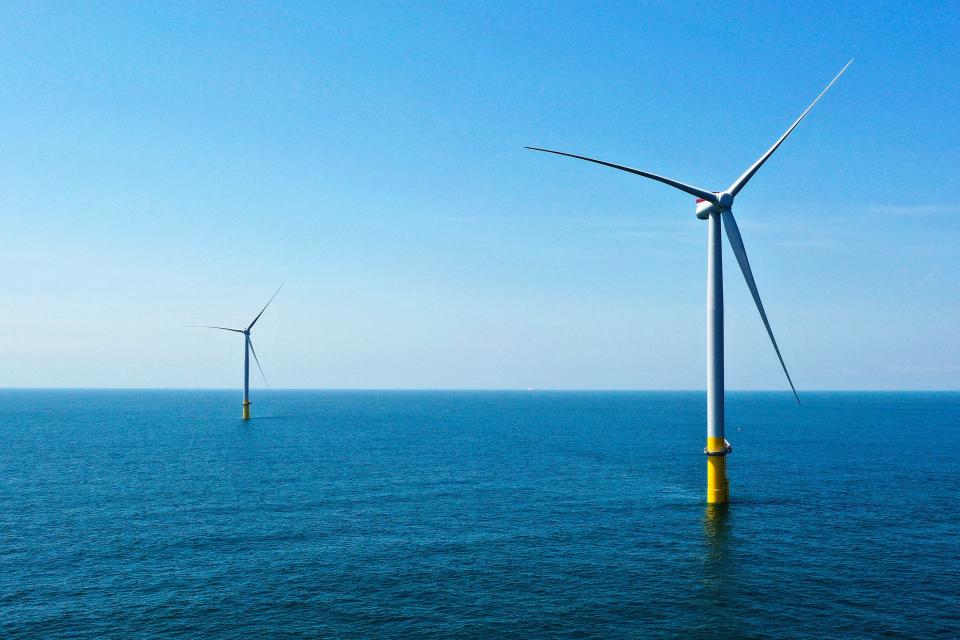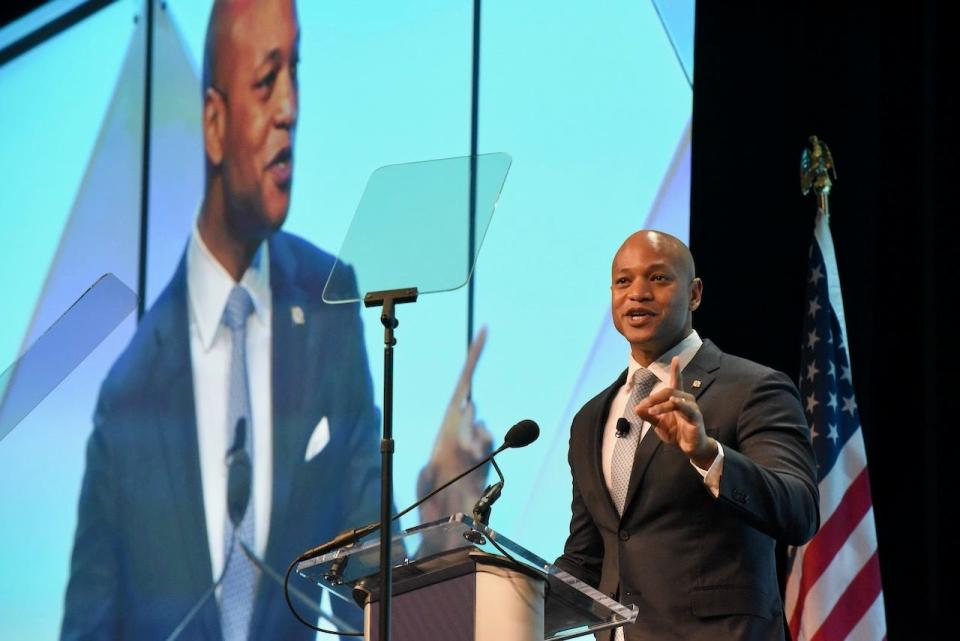'Offshore wind capital of America': What's in environmental bills signed by Wes Moore
Gov. Wes Moore signed four key environmental bills Friday, attacking air quality and setting the stage for more approvals on the host of environmental legislation approved by the General Assembly this session.
Moore signed the bills at an event at Tradepoint Atlantic in Sparrows Point, a “global logistics” center uniting roads, rails and ports, and where Ørsted’s wind energy facility is under development
“Because of the work happening today at Tradepoint Atlantic, Maryland is on track to become the offshore wind capital of America; it’s happening through this partnership with Ørsted, which is going to capture enough wind to power 300,000 homes, create 125 good-paying union jobs, and build a cleaner and greener world,” Moore said in a statement from his office. “Together we will build on the great work of our partners at Tradepoint Atlantic, Ørsted, and U.S. Wind to build the clean energy future we want to see in Maryland.”
Developments like MARWIN I and Momentum Wind by US Wind represent a projected 77 turbines 15 to 18 miles off the coast of Maryland and Delaware, including off the coast of Ocean City. Ørsted also plans on two developments of its own with Skipjack Wind I and II. The total of 69 turbines would be situated 20 to 21 miles off the coast of Maryland and Delaware.
Senate President Bill Ferguson, D-Baltimore City, attended the signing and tweeted that the new laws set the state on a “path of achieving our decarbonization goals and (spurring) our state’s economy in years ahead.”
Clean vehicle, offshore wind energy and more in new laws

Moore signed SB 781, the POWER Act, which sets goals for offshore wind energy; the cross-filed bills SB 224 and HB 230, known as the Clean Trucks Act of 2023, which would set sales targets for clean medium-heavy and heavy-duty trucks with the goal of reducing emissions; and HB 550, the Clean Transportation and Energy Act, which would extend rebates for electric chargers.
The Clean Trucks Act of 2023, HB 230 was sponsored by Del. Sara Love, D-Montgomery and Sen. Malcolm Augustine, D-Prince George’s, this rule requires manufacturers that sell trucks and school buses to sell an increasing annual percentage of zero-emission vehicles beginning in 2027.
Lindsey Mendelson, the transportation representative from the Maryland Sierra Club, said transportation is the largest source of climate pollution in the state. Forty-eight percent of particulate matter emitted by the transportation sector comes from medium- and heavy-duty vehicles.
“This bill would result in avoiding more than 116,000 cases of respiratory illness, like asthma,” Mendelson said.
Disagreement on coming cost to consumers

The Republican Caucus criticized the bills signed Friday. House Minority leader, Jason Buckel, R-Allegany, said “these bills drive up the costs for consumers and small businesses, making Maryland’s high cost-of-living even more unsustainable.”
But the Environmental Defense Fund said the adoption of the act will result in significant health benefits for Marylanders.
“It will go a long way in helping Maryland achieve Moore’s target of reducing greenhouse gases 60% by 2030 and is a core means of achieving a transition to 100% zero-emission truck and bus sales,” said Neda Deylami from the EDF in written testimony.
Maryland environmentalists were pleased overall with the climate change work of the Maryland General Assembly this session. Besides the bills signed Friday, other key targets passed, including tweaks to the Climate Solutions Act, which passed last year, requiring the state to reduce statewide greenhouse gas emissions; a bill to protect and improve the state’s tree canopy; and legislation to smooth a path for conserving undeveloped land.
The Maryland League of Conservation Voters said the changes to the Climate Solutions Now Act, “will facilitate implementation of the … Act by expanding renewable energy, reducing greenhouse gases and advancing environmental justice in our state agencies.”
Forest protections and more still await Moore's signature
Environmentalists also strongly backed Forest Preservation and Retention, HB 723/SB 526, which addresses Maryland’s overall goal to increase both forest and tree canopy, improve on the previously passed Forest Conservation Act, which addresses what developers must do, and provides a tax incentive for individuals to get a forest management plan, said Love, the House bill’s sponsor.
“Under the Forest Conservation Act, there is basically a four-to-one rule: If you cut down four trees you have to put up one,” said Love. What the Forest Preservation and Retention bill does “is really raises the bar and it says we’re moving to a one to one.”
That forest bill also won support from the Chesapeake Bay Foundation, whose Maryland staff attorney Matt Stegman thanked lawmakers for “their conscientious work to pass forest protection legislation.”
Forest Preservation and Retention is awaiting Moore’s approval.
WAR OF WORDS ON WIND: Wes Moore intensifies Maryland offshore wind energy push, drawing Andy Harris rebuke
NEW MARYLAND GUN LAWS: What's in controversial Maryland gun laws awaiting Wes Moore's signature?
CBF also supports SB 470, Maryland the Beautiful Act, which will establish goals and programs related to land conservation. It will also establish the Local Land Revolving Loan Program which will provide loans to land trusts in order to purchase land for conservation purposes.
President Joe Biden has a national goal of preserving 30 percent of America’s lands by 2030. Maryland is almost there, according to Sen. Sarah Elfreth, D-Anne Arundel, who presented this bill to the Budget and Taxation Committee on March 1.
“Science is clear, nature and space for nature is the foundation of the life support system in which we all depend,” said Dr. Mark Southerland, an ecologist representing the Howard County Conservancy as a member of their board of trustees, in the committee hearing. This bill is also awaiting Moore’s approval.
Some environmental bills didn't pass this session
Environmentalists are still ruing the failure of some bills, especially the Shoreline Restoration and the Reclaiming Renewable Energy Act.
Shoreline Restoration was introduced in both chambers as HB 602, sponsored by Del. Dana Stein, D-Baltimore and SB 417, sponsored by Elfreth; both did not make it out of their assigned committees.
The Shoreline Restoration bill would call on the state to identify areas of priority to increase the amount of living shorelines installed, stop the widespread use of waivers to harden, or develop, areas where living shorelines are viable and restart the successful assistance program for landowners to replace hardened shorelines with natural techniques.
According to the Department of Natural Resources Maryland has 3,190 miles of coastline, which equates to about 3.4% of the U.S. total of 95,471 miles. DNR defines a living shoreline to be the result of erosion control measures, including the use of fiber coir logs, sills, groins and breakwaters used in combination with sand and other natural materials such as marsh plantings.
The Associate Policy Director at the Maryland Association of Counties Dominic Butcho, said in the Feb. 15 hearing that Maryland, “critically underfunds how we maintain and how we invest in our coastline.”
The Reclaiming Renewable Energy Act, HB 718 has been on the legislative agenda for a few years now according to SirJames Weaver, the Environmental Justice Organizer at Progressive Maryland.
Led by Del. Vaughn Stewart, D-Montgomery, this bill has been voted on by both parties in the Senate for multiple years in a row, but has not passed the House. Even with overwhelming support in the Economic Matters hearing on March 9, it stalled.
“The bill stops ratepayers from providing subsidies to mostly out-of-state polluters who don’t need the money,” said Stewart in the hearing. This bill will “remove three dirty energy sources from our renewable portfolio standards,” those being trash incineration, bio-gas derived from animal waste or anaerobic digestion and woody biomass.
According to Weaver, “in 2011 trash incineration was moved from a Tier 2 energy source to a Tier 1 energy source, which made it eligible for renewable energy credits,” these would be paid for by ratepayers across Maryland.
Tier 1 renewable sources include solar, wind, qualifying biomass, methane from a landfill or wastewater treatment plant, geothermal, ocean, fuel cell that produces electricity from a Tier 1 source, hydroelectric power plants of less than 30 MW capacity, poultry litter-to-energy, waste-to-energy and refuse—deferred fuel according to the Maryland Public Service Commission.
Tier 2 renewable sources include hydroelectric power other than pump storage generation.
“This bill would have removed South Baltimore residents' financial payment into the incinerator,” said Weaver.
Since the bill did not pass, Weaver said this issue will, “continue to economically exploit our overly environmental communities of color in South Baltimore, leaving them behind.”
Advocates say that even though there were some gray areas in this year's legislation, there was growth for addressing climate change, animal protections and making Maryland a more sustainable state.
This article originally appeared on Salisbury Daily Times: Wind energy takes center stage in new Maryland environmental laws

